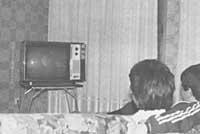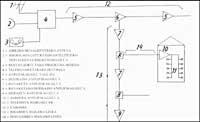Television or cable television
The fascination of KATB

To analyze how the FTA arose and spread, we must insist on the case of the United States, where this phenomenon was born and expanded.
The first systems were implemented in 1949 and were placed to solve the problem of places with poor reception of the air signal. In mountainous areas the signal does not equal all houses or villages. Sometimes it comes with a little snow, other times due to the phenomena of reflection appear on the screen a double image. To solve this, a place with good signal reception is sought and if a single antenna is placed, the signal is amplified and wired to all sites with legal quality.
In 1952, 70 systems had been implemented in the United States with 14,000 subscribers. In 1980 there were 4,225 systems and 15 million subscribers. In recent years, the number of subscribers has grown relatively quickly.
At first this system, although only implanted in places with poor signal, and then, and as the CAT industry grew, began to be implanted in other towns (where only you usually take one or two air chains). The goal was of course to increase the number of channels seen in these localities. To do this, by means of a good receiver, the channels of other countries were taken in the central talevanación of the village and from there they were distributed by cable to all the homes.
Signaling was limited by receptor conditions, distance and curvature of the ground. To obtain signals from long distances, microwave links, expensive systems for implantation and maintenance had to be used. However, since satellite broadcasts were launched, there are many TV channels away, with a satellite ground receiver not too expensive, which you can easily catch.
The creation of a specialized television program gave a great boost to the KATB. Each channel is dedicated to a single theme and all the time is dedicated exclusively to this topic, such as sports, culture, education, documentaries, adventure movies, language teachings, etc.
As a result, even in countries with good reception of airborne channels, CATB systems began to be implemented, in the vicinity of large cities and small cities.
No channels
The first CATV systems took two or three airborne channels and distributed them by cable. They only had this, as these channels sent them to subscribers who could not watch another television. KATB systems, implemented in countries where more channels could be received by air, were forced to increase their number of programs to offer subscribers an attractive system.
For technical reasons the first channel limit was 7. These channels were located in DOS and BIII of VHF (Table 1), three of them in DOS and four others in BIII, leaving without using another of each pair of channels used. This model is used for New York and Los Angeles air transmissions on VHF.
Technical barriers were quickly overcome and KATB systems were able to offer 12 channels, i.e. the maximum VHF capacity of a television receiver (12 in the US, only 11 in Europe). UHF channels could not be used in KATB. The high frequencies of these channels cause a great attenuation in the cable.
In order to increase the number of subscribers, many of the KATB systems began broadcasting more than 12 channels. As a normal TV receiver cannot tune more than 12 channels on VHF, KATB systems had to equip another device, the so-called converter. This connector connects between the antenna and the television and has its own frequency selector. The TV receiver is tuned into a fixed channel and the channel option is made through the converter (Figure 2).
KATB systems commissioned monthly rates to their subscribers due to the possibility of receiving more channels through the converter.
First connectors channel FM and 7 ( 5th Europe) used the frequency gap included in the interval. These frequencies are used in air transmissions (in radio communications and navigation systems), but since CATV transmission is restricted to coaxial cable, the use of these frequencies does not generate any interference problem. The use of the channels of this central band raised the number of programs from 12 to 20.
The next limit to the number of channels a CATV system could offer was that of the amplifiers existing on the cable line, the maximum frequency they could amplify. This limit was 300 Mhz, with a total capacity of 36 channels with average frequencies or higher than channel 13. The next increase, changing the capacity of the amplifiers, reached 360 Mhz and then 400 Mhz, with the possibility of sending 52 channels by cable. These days is reaching 450 Mhz with capacity of 60 channels.
Over the years many KATB systems have installed a double cable on their network. This doubles the capacity of the channels. Therefore, the current dual-cable system, theoretically, could offer 120 different programs.
In order to achieve country exclusives, the systems have increasingly offered channels and have been asked more and more. There is currently an acceptable technical capability for CAT service.
But the big problem today is finding a schedule to cover so many channels. Another problem will be to finance all these programs. Most KATB systems will use the combination of several programming sources to cover all of these channels.
Structure of a CATV system
The KATB system consists of a series of elements whose mission is to gather television programs with high technical quality and distribute them to the homes of subscribers with minimal degradation. Typical elements of the CATV system are shown in Figure 3.
TV signals entering the network can come from the air of an antenna, a microwave link, a satellite signal receiver or the network itself. Aerial signal antennas are built according to the frequencies of the channels to be used and installed in towers designed to overcome possible obstacles in the vicinity. To receive a special channel, it is necessary to frequently use antenna assemblies (several connected antennas).
When the television signal we want, when it is too far away or is generated in another country, you can take air using microwave links or satellite distribution. The signals introduced from the outside and those generated in the system itself are processed with a set of connectors, modulators and amplifiers. This set of devices is called teledistribution central. Here the frequencies and amplitudes of the signals are limited, modified and controlled to organize the range of channels offered by the KATB system. The result of these operations is the combination of incoming TV signals and this combination will be sent by cable to be distributed throughout the system.
For the distribution of signals, the coaxial cable is used, which is placed in positions similar to the telephone poles or soterra according to the demands of the community.
As there are losses in the coaxial cable, amplifiers are needed to gain the lost and equalize each signal, as losses vary depending on the frequency. The main line of the cable is called trunk and the amplifiers in it are the main ones.
In geographically appropriate areas, bypass amplifiers are installed. These amplifiers have two outputs. One feeds the trunk line that follows and the other feeds a secondary line of lower power. The secondary lines extend along the street or promenade. These lines also present losses and require distribution amplifiers. Smaller amplifiers, called expansion amplifiers, are used as they approach the end of the line.
To bring the signal to the addresses, through the secondary line and the derivative amplifiers, the tertiary lines come out. At the end of these lines and already in each house are installed input amplifiers. Passive distributors and divers are used to carry the TV signal from the input amplifiers to each home.
Paid television
The additional programming offered by the CATV system with special rates is paid.
With special treatment with film studies, KATB systems obtained the authorization to simultaneously display or shortly after (although before normal TV) the films exhibited by cinemas. For this privilege the KATB system had to put a special fee to subscribers, who were traveling part of this fee to movie studios. Therefore, the KATB system functions as the box office of a cinema.
At the end of the film, the KATB system had no right to cut movies, insert ads and adjust to a pre-set programming time. The TV stations that air, insert ads and cut movies, of course, if they fit their programming, which is a great advantage for KATB.

On the first paid television system, subscribers tried to charge each time they watched a show, as is done at the box office. However, this system presented some drawbacks. The technical team used to raise rates and control the reception of programs often failed. Many errors were generated and subscribers opposed this form of payment.
The most commonly used payment system currently is the monthly rate. The amount of special programming is added to the normal monthly rate. This simple method has proven to be suitable over time and is very well accepted by subscribers. To avoid seeing subscribers who do not pay for special programming, there are technical methods that we will not analyze here.
End
Today we can say that there is no competition in the distribution of the television signal to KATB. The other existing systems at the moment cannot transmit as many channels as KATB. In addition, KATB is the only system that in the near future has the possibility of two TV addresses. Because of these good conditions, it can be thought that the use of FTA will spread rapidly throughout Europe.







